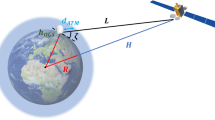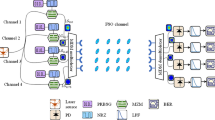Abstract
The free space optical communication technology tries to fulfill rising need for high bandwidth transmission capability link along with security and ease in installation. The free space optics uses beam of light to provide optical connection that can send and receive video, voice, and data information. In this paper a model analytical description of optical wireless communication systems operation performance efficiency evaluation in the presence of different fog density levels and noise is constructed. It is used for quantitative determination of the maximum range between transmitter and receiver depending on the signal transmission quality. Link margin, signal transmission, signal quality, received signal power, particle size distribution, optical depth, transmission data rate, signal time delay spread, signal noise and signal attenuation are deeply studied over wide range of the affecting parameters. Signal time delay spread and signal to noise ratio are deeply studied with using on-off keying modulation technique and are compared with their results with using binary phase shift keying in Li et al. (IEEE Trans Commun 55:1598–1606, 2007).




























Similar content being viewed by others
References
Kedar, D., & Arnon, S. (2004). Urban optical wireless communication networks: The main challenges and possible solutions. IEEE Communications Magazine, 42, S2–S7.
Uysal, M., Li, J., & Yu, M. (2006). Error rate performance analysis of coded free-space optical links over gamma–gamma atmospheric turbulence channles. IEEE Transactions on Wireless Communications, 5(6), 1229–1233.
Wu, H., & Kavehrad, M. (2007). Availability evaluation of ground-to-air hybrid FSO/RF links. International Journal of Wireless Information Networks, 14(1), 33–45.
Kahn, J. M., Krause, W. J., & Carruthers, J. B. (1995). Experimental characterization of non directed indoor infrared channels. IEEE Transactions on Communications, 43, 1613–1623.
Bohren, C. F., & Huffman, D. R. (1983). Absorption and Scattering of Light by Small Particles. New York: Wiley.
Li, J., Liu, J. Q., & Taylor, D. P. (2007). Optical communication using subcarrier PSK intensity modulation through atmospheric turbulence channels. IEEE Transactions on Communications, 55(8), 1598–1606.
Zhu, X., & Kahn, J. M. (2002). Free-space optical communication through atmospheric turbulence channels. IEEE Transactions on Communications, 50, 1293–1300.
Ohtsuki, T. (2002). Turbo-coded atmospheric optical communication systems. In IEEE international conference on communications (ICC) New York (pp. 2938–2942).
Uysal, M., Jing, L., & Meng, Y. (2006). Error rate performance analysis of coded free-space optical links over gamma–gamma atmospheric turbulence channels. IEEE Transactions on Wireless Communications, 5(6), 1229–1233.
Farid, A. A., & Hranilovic, S. (2007). Outage capacity optimization for free-space optical links with pointing errors. Journal of Lightwave Technology, 25(7), 1702–1710.
Popoola, W. O., Ghassemlooy, Z., & Leitgeb, E. (2007). Free-space optical communication using sub carrier modulation in gamma–gamma atmospheric turbulence. In 9th International conference on transparent optical networks (ICTON ’07) Rome Italy (Vol. 3, pp. 156–160).
Li, J., Liu, J. Q., & Taylor, D. P. (2007). Optical communication using subcarrier PSK intensity modulation through atmospheric turbulence channels. IEEE Transaction on Communications, 55, 1598–1606.
Al-Habash, M. A., Andrews, L. C., & Phillips, R. L. (2001). Mathematical model for the irradiance probability density function of a laser beam propagating through turbulent media. Optical Engineering, 40, 1554–1562.
Henniger, H., & Wilfert, O. (2010). An introduction to free space optical communications. Radio Engineering, 19(2), 203–212.
Barry, J. D., & Mecherle, G. S. (1985). Beam pointing error as a significant parameter for satellite borne, free-space optical communication systems. Optical Engineering, 24(6), 1049–1054.
Chen, C. C., & Gardner, C. S. (1989). Impact of random pointing and tracking errors on the design of coherent and incoherent optical intersatellite communication links. IEEE Transactions on Communications, 37(3), 252–260.
Arnon, S., & Kopeika, N. S. (1997). Laser satellite communication networkvibration effect and possible solutions. Proceedings of the IEEE, 85(10), 1646–1661.
Kolkai, Z., Biolkova, V., & Biolek, D. (2004). Model of atmospheric optical channel with scattering. Latest Trends on Communications, 5(4), 141–144.
Awan, M. S., Horwath, L. C., Muhammad, S. S., Leitgeb, E., Nadeem, F., & Khan, M. S. (2009). Characterization of fog and snow attenuations for free-space optical propagation. Journal of Communications, 4(8), 445–533.
Ketprom, U., Jaruwatanadilok, S., Kuga, Y., Ishimaru, A., & Ritcey, J. A. (2005). Channel modeling for optical wireless communication through dense fog. Journal of Optical Networking, 4(6), 291–299.
Ali, Mazin Ali A. (2013). Characterization of fog attenuation for free space optical communication link. International Journal of Electronics and Communication Engineering & Technology, 4(3), 244–255.
Aharonovich, M., & Arnon, S. (2005). Performance improvement of optical wireless communication through fog with a decision feedback equalizer. Journal of the Optical Society of America A, 22(8), 1646–1654.
Ferdinandov, E., & Mitsev, T. (2003). Link range of free space laser communication system. Microwave Review Journal, 9(2), 41–42.
Ricklin, J. C., Hammel, S. M., Eaton, F. D., & Lachinova, S. L. (2006). Atmospheric channel effects on free-space laser communication. Journal of Optical and Fiber Communications Research, 3, 111–158.
Author information
Authors and Affiliations
Corresponding author
Rights and permissions
About this article
Cite this article
Rashed, A.N.Z. Optical Wireless Communication Systems Operation Performance Efficiency Evaluation in the Presence of Different Fog Density Levels and Noise Impact. Wireless Pers Commun 81, 427–444 (2015). https://doi.org/10.1007/s11277-014-2137-9
Published:
Issue Date:
DOI: https://doi.org/10.1007/s11277-014-2137-9




